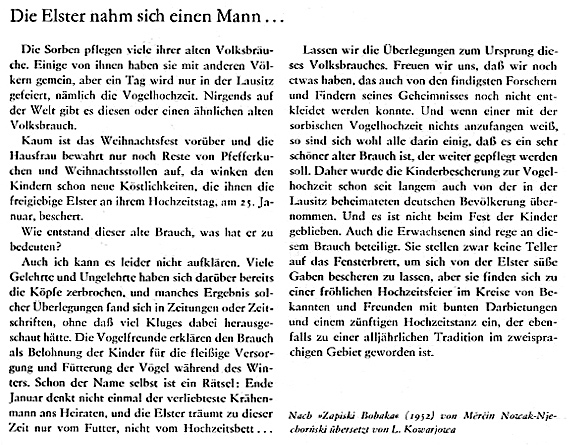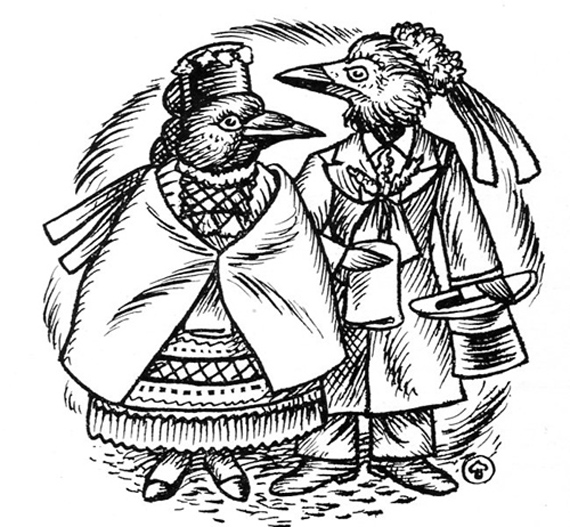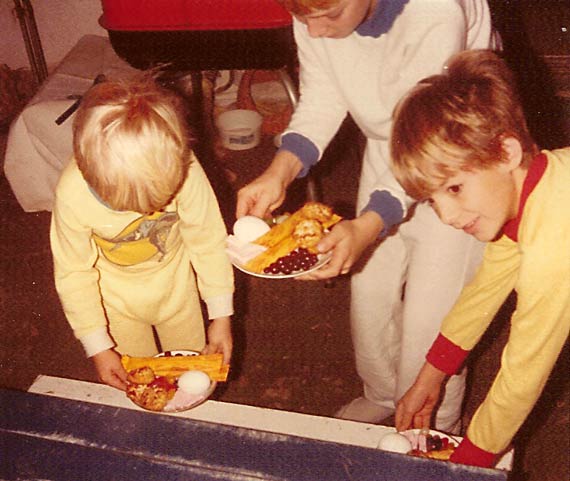Every January 25th, the Wends go to the birds. Want to know more?
Vogelhochzeit is a custom that was celebrated among many of the Wends in Texas until the 1940’s. It then gradually died out, until more recent years when attention was brought to it again. My mother recalled the custom very well and often told me about it when I was a child. After I was grown, and married a Wend, I determined that our children should enjoy the custom, too. They were likely the only children in Texas who celebrated the custom, but we kept it going for several years.
As to the origin of the custom, there are many theories… and they range all over the board. On one end of the spectrum, the theory of the origin of the custom is that prior to their Christianization, the Wends believed that the souls of their dead entered birds. In January, when the birds apparently seemed to be mating, the Wends would feed the birds in order to appease their ancestors. (The Wends were, in fact, very superstitious, especially prior to their Christianization). On the other end of the spectrum, it is said that the custom took on a meaning something like our “Easter Bunny”, but with a different twist. On the evening of January 24th, children would put out bread crumbs to feed the birds as they appeared to mate (thus, the “wedding” aspect of the custom)… and the birds, in turn, would “thank” the children for feeding them (especially in the winter) by giving them sweets and goodies. These are two ends of the spectrum as to where the custom originated and there are more that fall in between. Nonetheless, the custom became tradition…and even made its way to America, especially among the Texas Wends. I personally like what the great Wendish artist and poet, Mercin Nowak-Njechornski, wrote in his “Zapiski Bobaka” (a portion of which is attached in German and which I have translated into English). I concur with his conclusion as to the origin of the custom. I am also attaching a line drawing showing the “Vogelhochzeit”, as well as a photo of my children 30+ years ago on one of the mornings when they went to “collect” their goodies.

The Magpie takes a husband…
The Sorbs nurture many of their old folk customs. Some of these customs they share in common with other cultures, but there is one day that is only celebrated in Lusatia, namely, Vogelhochzeit. Nowhere else in the world is there such a custom or even one that resembles this old custom.
Hardly has the Christmas festival passed and the housewife finished putting away the remainder of the Pfefferkuchen and Weihnachststollen, then the children begin to beckon already for the treasures which the generous magpies share on their wedding day, January 25th.
From whence does this old custom come and what does it mean?
Unfortunately, I cannot explain it either. Many learned and unlearned people have already broken their heads[1] over this matter and many careful conclusions are found in newspapers and magazines, without much wisdom being put forth. Bird lovers explain the custom as a reward to the children for all of their trouble in feeding the birds during the winter. But, the name itself is a puzzle. At the end of January even the most lovely little crow doesn’t think about marriage, and the magpies at this time are thinking only of food, not of the wedding bed.
Let’s leave the deliberations of the origin of this folk custom. Let’s be happy that we still have such a thing that hides its meaning from even the most resourceful researchers and antiquarians. And if one doesn’t know where to begin where Vogelhochzeit is concerned, certainly everyone is agreed that it is a beautiful old custom and should continue to be nurtured. The children’s gifts of Vogelhochzeit, have already for a long time been taken over by German households. And it hasn’t remained a celebration just for children. The adults, too, are actively involved in this custom. Indeed, they don’t put out plates on the windowsill in order to receive sweet gifts from the magpies, but you will find themselves in a joyful wedding celebration in the area involving acquaintances and friends with colorful performances and a hearty wedding dance, which has become an annual tradition in this bilingual area.


